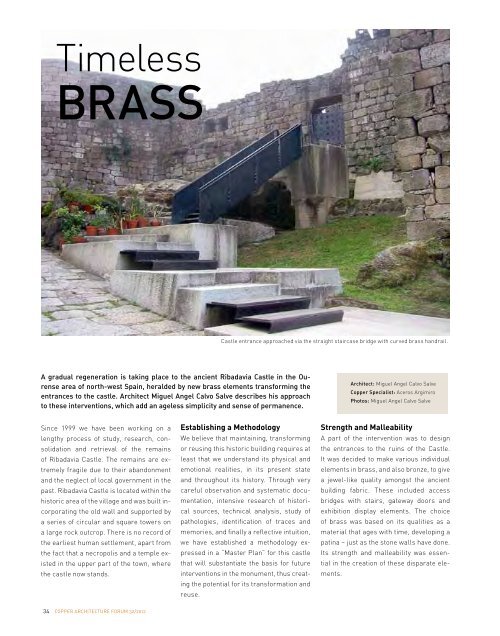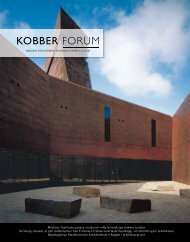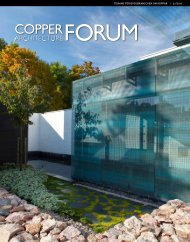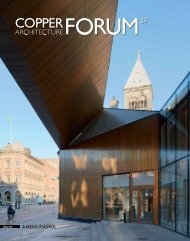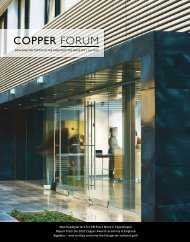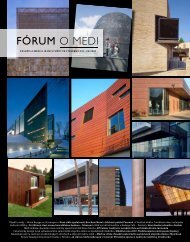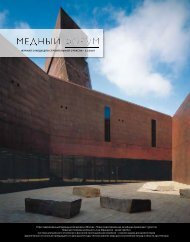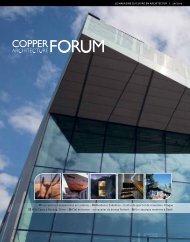Copper... a naturally changing surface and an air of permanence ...
Copper... a naturally changing surface and an air of permanence ...
Copper... a naturally changing surface and an air of permanence ...
Create successful ePaper yourself
Turn your PDF publications into a flip-book with our unique Google optimized e-Paper software.
Since 1999 we have been working on a<br />
lengthy process <strong>of</strong> study, research, consolidation<br />
<strong><strong>an</strong>d</strong> retrieval <strong>of</strong> the remains<br />
<strong>of</strong> Ribadavia Castle. The remains are extremely<br />
fragile due to their ab<strong><strong>an</strong>d</strong>onment<br />
<strong><strong>an</strong>d</strong> the neglect <strong>of</strong> local government in the<br />
past. Ribadavia Castle is located within the<br />
historic area <strong>of</strong> the village <strong><strong>an</strong>d</strong> was built incorporating<br />
the old wall <strong><strong>an</strong>d</strong> supported by<br />
a series <strong>of</strong> circular <strong><strong>an</strong>d</strong> square towers on<br />
a large rock outcrop. There is no record <strong>of</strong><br />
the earliest hum<strong>an</strong> settlement, apart from<br />
the fact that a necropolis <strong><strong>an</strong>d</strong> a temple existed<br />
in the upper part <strong>of</strong> the town, where<br />
the castle now st<strong><strong>an</strong>d</strong>s.<br />
34<br />
Timeless<br />
BRASS<br />
A gradual regeneration is taking place to the <strong>an</strong>cient Ribadavia Castle in the Ourense<br />
area <strong>of</strong> north-west Spain, heralded by new brass elements tr<strong>an</strong>sforming the<br />
entr<strong>an</strong>ces to the castle. Architect Miguel Angel Calvo Salve describes his approach<br />
to these interventions, which add <strong>an</strong> ageless simplicity <strong><strong>an</strong>d</strong> sense <strong>of</strong> perm<strong>an</strong>ence.<br />
COPPER ARCHITECTURE FORUM 32/2012<br />
Castle entr<strong>an</strong>ce approached via the straight st<strong>air</strong>case bridge with curved brass h<strong><strong>an</strong>d</strong>rail.<br />
establishing a Methodology<br />
We believe that maintaining, tr<strong>an</strong>sforming<br />
or reusing this historic building requires at<br />
least that we underst<strong><strong>an</strong>d</strong> its physical <strong><strong>an</strong>d</strong><br />
emotional realities, in its present state<br />
<strong><strong>an</strong>d</strong> throughout its history. Through very<br />
careful observation <strong><strong>an</strong>d</strong> systematic documentation,<br />
intensive research <strong>of</strong> historical<br />
sources, technical <strong>an</strong>alysis, study <strong>of</strong><br />
pathologies, identification <strong>of</strong> traces <strong><strong>an</strong>d</strong><br />
memories, <strong><strong>an</strong>d</strong> finally a reflective intuition,<br />
we have established a methodology expressed<br />
in a “Master Pl<strong>an</strong>” for this castle<br />
that will subst<strong>an</strong>tiate the basis for future<br />
interventions in the monument, thus creating<br />
the potential for its tr<strong>an</strong>sformation <strong><strong>an</strong>d</strong><br />
reuse.<br />
Architect: Miguel Angel Calvo Salve<br />
<strong>Copper</strong> Specialist: Aceros Argimiro<br />
Photos: Miguel Angel Calvo Salve<br />
Strength <strong><strong>an</strong>d</strong> Malleability<br />
A part <strong>of</strong> the intervention was to design<br />
the entr<strong>an</strong>ces to the ruins <strong>of</strong> the Castle.<br />
It was decided to make various individual<br />
elements in brass, <strong><strong>an</strong>d</strong> also bronze, to give<br />
a jewel-like quality amongst the <strong>an</strong>cient<br />
building fabric. These included access<br />
bridges with st<strong>air</strong>s, gateway doors <strong><strong>an</strong>d</strong><br />
exhibition display elements. The choice<br />
<strong>of</strong> brass was based on its qualities as a<br />
material that ages with time, developing a<br />
patina – just as the stone walls have done.<br />
Its strength <strong><strong>an</strong>d</strong> malleability was essential<br />
in the creation <strong>of</strong> these disparate elements.


